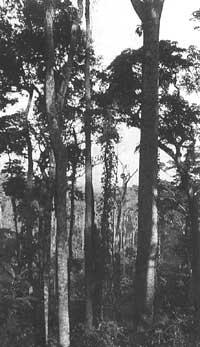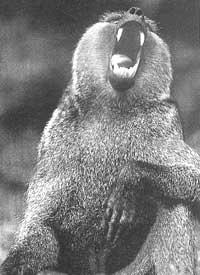Ebola: hidden in the woods?
Disability

All we know about the Ebola virus can be grouped into few hypotheses. Its origin, development lines or means of transmission are unknown today. Among emerging pathogens, Ebola has become the nightmare of all researchers.
When the last violent appearance occurred in May 2007, the eyes of the whole world turned to Zaire, attracted by those tremendous news and media images. It seemed like a science fiction: a few hours after being infected by an evil virus, with fever, nausea and hallucination, many people died. That virus was punished to the point that the body corrupted and could not know exactly the routes of transmission, so panic was imposed.
With time. News frequency on the Zaire epidemic has been reduced. The reasons have not been clarified but it is no longer news. However, the latest data from the Balikosta Tai Forest indicate that the Ebola virus will soon have to be discussed again. It seems that researchers are increasingly close to the basic carrier of the virus that causes the infection. The news is that we are writing these lines. To reach us, sleep can be reality.
Research Steps

Fifteen years ago a group of scientists began to investigate the chimpanzees of the Tai forest of Balikosta. Its ecology is very suitable to form large groups of chimpanzees and the aim of the study was to analyze the living conditions of a group.
Between 1992 and 1994, two pests were observed that tripled the chimpanzee mortality rate: The group of chimpanzees went from 60 to 30 units. In all cases, the symptoms of the disease that attacked the chimpanzees were similar: the bodies were filled with blood, the pathogens that scratched the tissues and are believed to attack the nervous system. All chimpanzees were infected and died a few days later.
In 1994 and during the autopsy of a dead chimpanzee, a researcher was contaminated by the pathogen. Because they could not treat him in Balikosta, he was transferred to his hometown, Switzerland. The symptoms of the disease were losing strength and three weeks later the researcher began to recover.
In the conviction that the researcher's disease could be related to the appearance of the Ebola virus, researchers from the Center for Research for Disease Control and the Pasteur Institute began to analyze their blood. They were right. There they discovered the Ebola phylobirus, but not one of the three known viruses until then, but a fourth. Aware of the importance of discovery, researchers from both institutions returned to Balikost. It was May. In the course of it, the media spread the unfortunate news: The disease that violently attacked the Zairean people of Kikwit was a new appearance of Ebola.
Why there and then?
Most of the efforts made so far have been aimed at identifying pathways of phylobirus transmission. The problem, however, requires clarifying the origin, that is, what the virus transmits and what accelerates the development of the epidemic.

Until now monkeys and chimpanzees have been considered as original carriers of the virus, but in this theory anyone can find a basic error: a virus that quickly kills the carrier, which is the case of Ebola, which cuts its transmission routes and did not occur in the appearances of Yambutu, Marburg, Reston and Kikwit. Researchers believe that monkeys or chimpanzees are the second carrier and, like man, have been contaminated by other things. Efforts have since been focused on isolating the virus and detecting the first animation it uses in the transmission chain.
According to the latest data published by the magazine La Recherche, insects and rodent mammals have been found that have been considered as possible carriers around the Tai forest. The first results indicate that the development of the Ebola virus would be directly related to the rainy season, in which the living conditions of the environment change drastically when the rains occur and, at the same time, the population increases around the main peoples. It is undoubtedly the preferred time for the proliferation of insects and rats. According to the researchers, it is at this time that genetic mutation of the Ebola virus can occur: create a reproductive sequence in mammals and, therefore, make an appearance of pests using different means of transmission.
This hypothesis opens a new way of research. Also for fear. In fact, if man acquired the ability to know and master the origin of a dangerous agent like Ebola, he could create an agent suited to his interests. New discoveries allow us to continue discussing the ethics of science.
The most famous manifestation of the virus occurred on the banks of the Ebola River between Sudan and Zaire in 1987. Hence the name of the two main manifestations of the virus: Although many people believe it is Ebola from Sudan and Ebola from Zaire, the path of this evil virus is not limited to Africa. On the contrary, it is known worldwide for its appearances in Germany and the USA.
The virus attacked 31 people in the German city of Marburg in 1967. They were all Behring Work workers. Although in the beginning it was mentioned that it could be a violent manifestation of rabies, the development of the disease did rule out this hypothesis. The virus causes internal bleeding. Sew the body with clot and scratch the tissues. It corrupts the skin of the face and legs and finally attacks the nervous system. After the heavy hallucinations, the virus took the 31 friends of Marburg. No one dared to reveal reliable data of the origin of this terrible disease. They studied laboratory tools and samples, but found no trace. Subsequently, it was found that the presence of the virus was detected through the study of the blood of the four monkeys from Uganda. The main transmission melonisms were the fluids of the human body.

15 kilometers from the US capital, the Research Production laboratory in the city of Resten also have knowledge of Ebola, where it last appeared in the virus in 1989.
Renewing what happened in Marburg, about 100 Philippine monkeys suffered the symptoms of the disease and after analyzing their blood at the Fort Dictrick military research center, the Ebola ghost expanded again. As was officially said, the virus did not infect humans and made it disappear by eliminating carriers of the virus. However, New Yorker journalist Richard Preston says: Ebola was being used to study bacteriological weapons. This was based on data hidden by military institutions, but the U.S. Army has repeatedly denied Prestón's theory. Presence in the US has an important characteristic: for the first time it was shown that the Ebola virus can spread through the air. Although it did not attack humans, researchers recognized that it can spread without contact with fluids.
As we know so far, the last appearance of Ebola took place in Zaire last May. On the other hand, this terrible virus was already known in this region and what happened in 1976 in the villages of Nzara and Maridi in Sudan was renewed last year in memory of the natives.
Hundreds of people died in this town. Among those who managed to escape were apparently the inhabitants of the virus. In a few days they crossed the border with Zaire and reached the mission of Yambutu. The virus spread to about 35 villages, condemning thousands of people to die. As in Marburug, Ebola de Zaire was infected by direct contact with the fluids of the sick, such as blood or tears.
Dolphin mechanisms Recognizing that diseases in Germany, USA and Zaire are different manifestations of the Ebola virus, researchers began to analyze the mechanism it uses to spread viruses. Through the electron microscope they have been able to verify that the cells attacked by the virus are completely destroyed. The cell itself attracts the virus. Once introduced into the cell, Ebola takes a few hours to stop all its functions and rot the cell itself. The same process is repeated repeatedly in all cells. As a result, it attacks all organs and rots tissues. The pathways of transmission of the disease are saliva and blood. They are said to have direct contact with them to spread the disease. However, Reston's presence confirmed possible air pollution. The virus first attacks the blood clotting system. As soon as it spreads, bleeding is the first cause of death. While fever, nausea and diarrhoea lead to minimum protections for patients attacked by Ebola, the agent continues to attack. It scratches the tissues and organs, especially the liver and lungs, until putrefaction. Mortality gives fame to the most dangerous Ebola virus. 90% of infected patients die 10 days after first contact with the virus. At the moment, there is no remedy to stop the path of this terrible virus. |
Security International Health Organizations demand P-4 levels of biosecurity in order to manipulate the Ebola virus. There are few facilities in the world that offer this level of security. The manipulation of HIV from AIDS, for example, requires P-2 and P-3 levels of biosecurity. The potential risk of Ebola exceeds these levels and special measures must be taken to work with the virus. Ebola virus studies are being conducted at the U.S. Atlantic City Center for Disease Control Research (CDC). The laboratory is completely isolated: to enter it you have to dress with the special garments mentioned above, from which nothing can be taken. Notes received by researchers are sent abroad by fax or email. What seen in the movies has a lot to do with reality. |
Buletina
Bidali zure helbide elektronikoa eta jaso asteroko buletina zure sarrera-ontzian











